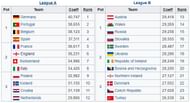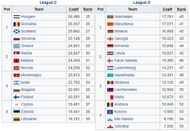You might know exactly what I'm talking about or you might have heard of it but forgotten. Keep reading further to know exactly what this tournament is and what this will mean for your favorite European nations.
The 2018-19 UEFA Nations League starts on 6 September 2018. The tournament will begin it's group stages next week and will continue on till 20 November 2018. The rest of the tournament will resume next year in June with the winners being decided on 9 June 2019.
The concept of the UEFA Nations League would see all 55 of UEFA's national teams divided into a series of groups based upon a ranking formulated using their recent results, where they would be promoted and relegated to other groups according to their results within the group. The fixtures will majorly replace the international friendlies the national teams usually play.

There will be 4 Leagues in the inaugural version of the Nations League. League A will have the top 12 European teams according to their rankings. League B will have the next 12. League C will have the next 15 and League D will have the next 16.

The leagues will be divided into 4 Groups each. The top team of each group in League B and lower will gain promotion to the higher League for the next season. The bottom placed team of each group will be demoted to the lower league for the next season for every league except D.
The 16 Group Winners from each league will also get a direct qualification to the Euro 2020 Qualifications Play-Offs. This decision has drawn criticism as it might allow weaker teams to have a chance to qualify for the Euro over stronger teams. However, the teams can still qualify through the regular qualification process for the Euro 2020.
League A and B: The Teams, format and schedule
To further explain the happenings of the tournament, let's take a look at the individual groups and explain how the tournament will proceed.
League A
League A will consist of 12 teams which are the 12 highest ranked European Teams. The 12 teams will be divided into groups of 3. The teams in the 4 groups will play each other twice, once in their home and once away. The teams were seeded in 4 pots as per their rankings. The pots are as shown in the image.

These teams were then drawn into their respective groups. The draw took place at SwissTech Convention Center in Lausanne, Switzerland on 24 January 2018. The groups formed are as follows:
Group 1 - Germany, France and Netherlands.
Group 2 - Belgium, Switzerland and Iceland.
Group 3 - Portugal, Italy and Poland.
Group 4 - Spain, England and Croatia.
The tournament begins on 6 September 2018 with Germany facing France at the Allianz Arena in Munich at 8:45 PM CET. The group stages conclude with Portugal facing Poland on 20 November 2018 at the Estadio D. Afonso Henriques in Guimaraes.
The 4 bottom placed members of their respective groups will be relegated to League B irrespective of their rankings. They will play the 2019-20 UEFA Nations League in League B. The 4 winners of their respective groups will proceed to the UEFA Nations League Finals in June of 2019.
League B
League B will also have 12 teams much like League A. They were the 12 highest ranked teams in Europe after the teams in League A at the time of seeding. The teams were again divided into 4 pots. The pots are shown below.

These teams were drawn into their respective groups as follows:
Group 1 - Slovakia, Ukraine and Czech Republic.
Group 2 - Russia, Sweden and Turkey.
Group 3 - Austria, Bosnia and Herzegovina and Northern Ireland.
Group 4 - Wales, Republic of Ireland and Denmark.
Czech Republic will face Ukraine in the latter's home while Wales will host Republic of Ireland on 6 September 2018 8:45 pm CET to kick off League B. The final fixture is on 20 November 2018 with Sweden playing Russia at the Friends Arena, Solna.
The winners of every group will gain promotion to League A at the expense of the bottom placed teams in League A. The bottom placed teams of League B will however be relegated to League C for the next season.
League C and D: The format, teams and schedule
Unlike Leagues A and B, the two lower leagues will have more teams. League C will have 15 while League D will have 16. They will follow the similar promotion and relegation rules except for League D from which there will obviously be no relegation.
League C
By far the most complex division of the tournament. League C will have an odd 15 participants. These are the teams that were ranked 25-39 at the time of seeding. Due to the oddity in the number of participants, Group 1 was decided to have a team less than the other groups. Pot 4, as a result also had one team less in it.

These teams were then sorted into their respective groups as follows:
Group 1 - Scotland, Albania and Israel.
Group 2 - Hungary, Greece, Finland and Estonia.
Group 3 - Slovenia, Norway, Bulgaria and Cyprus.
Group 4 - Romania, Serbia, Montenegro and Lithuania.
Slovenia will host Bulgaria and Norway will host Cyprus in the opening games for the group on 6 September 2018 at 8:35 PM CET. The final day of this league will have 3 matches as Scotland take on Israel on home soil, Serbia welcome Lithuania and Montenegro hosts Romania.
The winners of each group will be promoted to League B for the 2019-20 season. But, not all the bottom placed teams will be relegated. The bottom placed teams of Groups 2, 3 and 4 will be relegated for sure. But the 3rd placed teams of all groups will be then ranked according to their statistics. The bottom placed team among all the 3rd placed teams will be relegated down to League D finally.
League D
The bottom league of the tournament drew criticism due to the decision made to allow the group winners from this stage a play-off spot in the Euro 2020 qualification. Nonetheless, there are 16 teams in this league. They were the bottom 16 European teams at the time of seeding. They were placed in 4 pots of 4 teams each. The pots are as follows.

The groups are as follows:
Group 1 - Georgia, Latvia, Kazakhstan and Andorra.
Group 2 - Belarus, Luxembourg, Moldova and San Marino.
Group 3 - Azerbaijan, Faroe Islands, Malta and Kosovo.
Group 4 - Macedonia, Armenia, Liechtenstein and Gibraltar.
Kazakhstan will host Georgia in the Astana Arena on 6 September 2018 at 4:00 PM CET to begin this league. The games end with Kosovo facing Azerbaijan and Malta hosting Faroe Islands on 20 September 2018 at 8:45 PM CET.
The winners of each group will be promoted to League C for the next season. The bottom placed teams won't be relegated as this is the lowest division in the League.
The 2019 Nations League Finals
The conclusion of the Nations League comes next year in June. The 4 group toppers in League A will face each other to win the UEFA Nations League. The Finals start on 5 June 2019 with the the first semi-final taking place on that day. The second semi-final will take place the very next day on 6 June 2019. The tournament will conclude on 9 June with the third-place and Grand Final matches.
The entire Finals will be hosted by one single country. Two stadiums with at least 30,000 capacity will be hosting the 4 games in the Finals. Poland, Italy and Portugal have expressed their interest to host the Finals. The deadline of submitting the bids to host the Finals is on 31 August 2018. As Poland, Italy and Portugal are in the same group, Group A3, the group winner is expected to be announced as the host.
The winners of the Nations League will receive a prize money of €4.5 million. The runner-up will get €3.5 million. The third-placed team will receive €2.5 million and the fourth-placed team will get €1.5 million as prize money. In addition to this, every participating nation will get a solidarity fee. The solidarity fees are:
- League A - €1.5 Million.
- League B - €1 Million.
- League C - €750,000.
- League D - €500,000.
The Individual Group winners of every league will also get an extra reward. The group winners of every league will receive:
- League A - €1.5 Million.
- League B - €1 Million.
- League C - €750,000.
- League D - €500,000.
The group winners of all 4 Leagues will eventually decide 4 slots in the UEFA Euro 2020 Championships.
